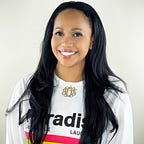Finding My Fit in a White World
I’ve always had to find my own fit in the world. Recent events with the murders of unarmed Black U.S. citizens by police not only ignited me into action to advocate and push for justice but also sparked an internal examination of how I came to value myself within the mixed messages about race and culture that I grew up experiencing.
I am mixed in more ways than race alone.
I am Black. I am a Native American of the Kiowa Nation of Oklahoma. I am female. I am an identical twin. I speak two languages. I am an American who lived in Europe for almost half of my life. I am married to a white, Eastern-European male. This cocktail of color, culture and geography is packaged in the 4’11” woman that I am today.
My elementary school years that were spent in the U.S. is where I struggled to fully fit in with my Black, white and brown peers.
The message of not being “Black enough” by Black students and clearly not being white by white students were heard loud and clear.
I did not allow myself to suffer on the fringes though. I used my outgoing personality to befriend most of my class through humor and kindness although I had no real alliance with any one group except with my teachers. I was always a diligent, honor-roll student, and consistently became the teacher’s pet. I quickly learned that “having brains” was my invisible superpower to win attention and praise. The rejection from my peers fueled the need for adult acceptance that was critical to my self-esteem. This was my way of “fitting in”.
I’ve always been extremely competitive. Board games, hop scotch, a school test — you name it, I had to be first. At school, I would win scratch-and-sniff stickers, T-shirts, free lunch certificates to Pizza Hut but never the gold medal of acceptance from my Black peers.
My family then relocated to England in the U.K. where we lived in an idyllic English town in the county of North Yorkshire where me and my twin sister were the only Black students at the local High School. Our all white, English classmates welcomed us with curiosity and amusement, and eventual acceptance however, we never really found a firm “fit”.
We were different, and would always be different.
Discussions about race were largely avoided by our peers — conversations outside school work or friendships would be more about culture. When the subject of race would surface, the opinions given were starkly racists. I was told on one occasion by my classmate with whom I considered a friend, “I don’t really like dark, Black people, but your color is OK.”
Throughout these formative years, largely void of any consistent, diverse racial representation, I would read and absorb magazines, literature and music by and about Black history and culture, and gain knowledge and insight about my Native American people. But there was still a disconnect to what I was reading in the whitewash of my everyday life.
I learned how to fit in my white world, but I in turn, had no fit. I wanted to be seen as a winner — a gold medalist in my world where my skin color seemed to define me louder than I myself could.
I’ve experienced what would be considered today as hate crimes that made me feel further alienated from my white environment during my time at university in one of England’s once affluent coastal, fishing towns.
One incident took place in the town’s city center where me and my twin sister were walking together. A man came up behind us and started kicking us, causing us to trip over our own feet. It took me a few seconds to realize what was happening and I managed to move aside and pull my sister away from his path as he stomped on by us.
I recognized a symbol on his jacket to be that of the “National Front”, a far-right, fascist political party in the U.K..
We knew of their presence in the area and had now been a target. I realized that I’d absorbed and accepted my white environment, but there was always a reminder that my blackness would never be fully accepted.
I had a recent conversation with my bestie who too is biracial. Her father is English and her mother is Belizean. For a time, she grew up in the same English environment that I did.
We were discussing a comment we’d heard in a documentary that we were watching where a biracial interviewee talked about not feeling Black or white when growing up but feeling more like “Other” due to the impact of her experiences with her peers that were similar to mine.
Whilst I instantly related to this description, my friend did not. She adamantly declared that she had never felt like that. I understood her point of view and her accompanied annoyance that a human would ever consider themselves “Other”, but I saw identifying with this category as something positive. From my childhood and young adult experiences, I’d had no real fit. There were no relational racial or cultural cubby holes, lockers or shoes for me to fit into.
I’ve had to learn to define and accept my own blackness within a white world.
I’ve had to learn to champion myself and amplify my own messages of the importance of inclusion and representation. My blackness may not look, sound or act like yours — because it is mine. It is something “Other” than yours, and that’s OK. I am Black. I am Native American. And above all, I AM Gold.
